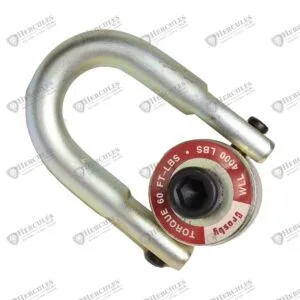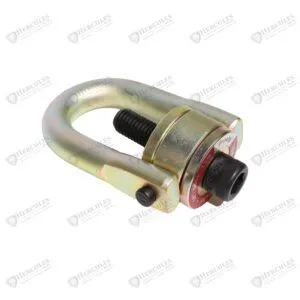Swivel Hoist Rings: Usage, Applications, and Best Practices
Swivel Hoist Rings: Usage, Applications, and Best Practices
In the field of heavy lifting and rigging, safety and efficiency are paramount. One indispensable tool that ensures both is the swivel hoist ring. Designed to provide a secure lifting point, swivel hoist rings offer versatility and reliability in various lifting scenarios. This blog will delve into the usage, applications, proper handling, and essential facts about swivel hoist rings.
What are Swivel Hoist Rings?
Swivel hoist rings are lifting devices used to attach loads securely to lifting equipment like cranes or hoists. Unlike traditional lifting eyes or hooks, swivel hoist rings can rotate 360 degrees and pivot 180 degrees, offering greater flexibility and alignment during lifting operations. This adaptability makes them ideal for lifting loads at various angles without compromising safety.
Usage and Applications of Swivel Hoist Rings
Swivel hoist rings are employed across a range of industries, including construction, manufacturing, shipping, and even aerospace. Here are some typical applications:
- Construction Sites: Used for lifting heavy building materials, machinery, and structural components. Their ability to swivel ensures that loads are lifted evenly, reducing the risk of tipping or dropping.
- Manufacturing: In manufacturing plants, swivel hoist rings facilitate the lifting and moving of heavy equipment and parts. Their design allows for precise positioning, which is crucial in assembling large machinery.
- Shipping and Logistics: Essential in ports and warehouses, swivel hoist rings help in handling cargo, containers, and large crates, ensuring they are securely lifted and transported.
- Aerospace: In the aerospace industry, where precision is key, swivel hoist rings are used to lift and position delicate components like engines and fuselage sections.
RELATED PRODUCTS AVAILABLE ONLINE AT HERCULESSLR.COM
HOIST RING 5/8”-11X2.75” SWIVEL HR-125 WLL 4000 LBS CROSBY Part #:1016924
HOIST RING 1”-8X3.00” SWIVEL HR-125 WLL 10000 LBS CROSBY Part #:1016964
How to Use Swivel Hoist Rings Correctly
To maximize safety and effectiveness, it’s crucial to use swivel hoist rings correctly. Here’s a step-by-step guide:
Inspection Before Use: Always inspect the hoist ring before use. Check for any signs of wear, corrosion, or deformation. Ensure that the pivot and swivel mechanisms move smoothly.
Correct Installation:
- Mounting: Install the hoist ring by threading it into a tapped hole or attaching it to a suitable surface using bolts. Ensure the mounting surface is flat, clean, and capable of handling the load.
- Torque Specifications: Tighten the hoist ring to the manufacturer’s recommended torque specifications to avoid over-tightening or under-tightening, which can compromise the lifting capacity.
- Load Capacity: Always adhere to the rated load capacity of the hoist ring. Never exceed the maximum load limit, as this can lead to equipment failure and potential accidents.
- Load Alignment: Ensure the load is properly aligned with the hoist ring. The swivel feature allows for natural alignment, but it’s essential to start with the load reasonably centered to prevent side loading, which can cause undue stress.
Lifting and Moving:
- Gradual Lifting: Lift the load gradually to ensure stability. Sudden jerks or rapid lifting can create dynamic forces that exceed the hoist ring’s rated capacity.
- Monitoring: Continuously monitor the load and hoist ring during lifting operations. Look out for any signs of strain or instability.
- Post-Use Inspection: After use, inspect the hoist ring for any damage or wear. Proper maintenance and timely replacement of worn parts are critical for ongoing safety.
Essential Facts and Statistics
Understanding the technical specifications and standards of swivel hoist rings can enhance their effective use. Here are some key facts and statistics:
- Material Composition: Swivel hoist rings are typically made from high-strength alloy steel, which provides durability and high load-bearing capacity. They are often coated with corrosion-resistant finishes to enhance longevity.
- Load Capacities: Depending on the size and design, swivel hoist rings can handle loads ranging from a few hundred pounds to several tons. Always refer to the manufacturer’s specifications for exact load ratings.
- Safety Standards: Swivel hoist rings must comply with safety standards such as ASME B30.26, which specifies requirements for rigging hardware. Compliance ensures that the hoist rings are tested and rated for safe lifting.
- Inspection Frequency: Regular inspections are required and crucial. For high-use applications, daily inspections may be necessary. For less frequent use, inspect before each use and at regular intervals defined by the working conditions.
Tips for Enhanced Safety and Efficiency
To further enhance the safety and efficiency of using swivel hoist rings, consider the following tips:
- Training and Certification: Ensure that all personnel involved in lifting operations are properly trained and certified. Understanding the correct use of lifting equipment can prevent accidents and improve efficiency.
- Use Appropriate Accessories: Combine swivel hoist rings with compatible lifting slings, shackles, and other rigging accessories to ensure a secure and balanced lift.
- Environmental Considerations: Be mindful of the environment in which the hoist rings are used. Extreme temperatures, corrosive environments, and other harsh conditions can affect the performance and longevity of the hoist rings.
- Regular Maintenance: Implement a regular maintenance schedule to inspect and maintain swivel hoist rings. Lubricate pivot and swivel points as needed and replace any damaged components promptly.
- Documentation: Keep detailed records of inspections, maintenance, and load tests. Documentation helps track the condition of hoist rings and ensures compliance with safety regulations.
Conclusion
Swivel hoist rings are invaluable tools in the world of heavy lifting, offering unparalleled flexibility and safety. By understanding their usage, proper handling, and maintenance, industries can ensure efficient and secure lifting operations. Whether in construction, manufacturing, or any field requiring heavy lifting, incorporating swivel hoist rings into your rigging toolkit is a step toward safer and more effective material handling. Always follow manufacturer guidelines and industry standards to maximize the benefits of these versatile lifting devices.
——————————————————————————————————————————————
The Hercules Group of Companies encompasses a wide portfolio of products and services across 7 diverse companies.




